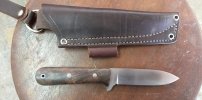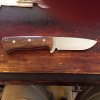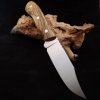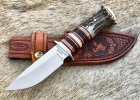- Joined
- Nov 9, 2006
- Messages
- 541
Is there a convention for the location of the plunge relative to a sharpening notch? I've been putting the notch right in front of the plunge using a round file after the rough grind.
I just used a drill press to drill a hole before profiling. I am also trying heat treating first and will grind after. I now have a nicer file guide so can place the plunge better.
Is centering the plunge on a half round sharpening notch something to strive for?
Thanks
I just used a drill press to drill a hole before profiling. I am also trying heat treating first and will grind after. I now have a nicer file guide so can place the plunge better.
Is centering the plunge on a half round sharpening notch something to strive for?
Thanks






